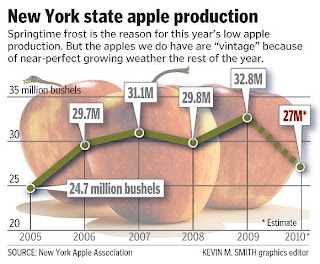Jeffrey Blackwell • Democrat and Chronicle Staff writer • September 22, 2010
Local apple growers are using a word to describe this year's crop that is usually reserved for the grape growers in the region: "vintage."
"We've had plenty of sun, nice hot weather and lots of rain," said Marty Schutt, owner of Schutt's Apple Mill in Webster.
"The apples really developed a lot of sugar, good color and a lot of size. It's kind of a vintage year."
The high quality of the crop comes as a relief to some growers because production is expected to be down from nearly 33 million bushels last season to an estimated 27 million bushels this year.
The apple industry in New York is second in production in the United States only to Washington state.
But local growers say the state is not an easy place to do business because of labor shortages and high productions costs.
"This is one of the prime areas, climate wise, for growing fruit," said Doug DeBadts Sr., the third generation in his family to grow apples in Sodus. "If there was a way to pick up the land and move it elsewhere to the same kind of climate, I think there would be exodus."
Local apples are sold at local stands and to retail stores and processors across the country and around the world. An apple grown on a Wayne Country farm can end up at a local farmer's market or grocery store in India.
On prime land and climate protected by Lake Ontario, the apple industry has a 200-year tradition in New York and is important to both local communities and the state, said Peter Gregg, a spokesman for the non-profit New York Apple Association.
"The apple industry is a vital part of the rural upstate economy," he said. "The cash value of our crop this year should come out to about $250,000."
"Then when you add in all the added value, the processing, delivering it to market and so on, it turns into roughly a billion dollar industry every year."
Much of the state's apple industry is concentrated near the shores of Lake Ontario east and west of Rochester. Wayne County is No. 1 in the state for apple production.
The county is also the home of the plant that produces Mott's apple juice and applesauce, as well as drink mixers, Clamato, Snapple drinks and more.
The plant goes through 14 million bushels of apples a year.
"Any excess in production we have goes to Mott's and is made into applesauce and hopefully shows up on some of Wegmans' shelves," said Schutt.
On the DeBadts farm in Sodus, Wayne County, harvest is under way 10 days earlier than normal because of the warm summer.
Workers, many of them from Mexico and Latin America, pluck apples from tree branches with speed and a gentle hand at the farm.
Juanita Perez, the picking crew leader, has worked at DeBadts farm for 23 years, splitting her time between the U.S. and Mexico.
She inspects the apples in the bins and pulls out those damaged by a recent hail storm.
"Some of them look good, some not so good," she said.
Farmers have had their challenges this year. An early frost in April cut back the size of the harvest, but the quality of the fruit will make up for the smaller crop, said DeBadts.
"We were nervous early on with a spring frost and that has affected production in certain areas and some blocks (or trees), but what's there is very good," he said.
This should be a good time to be in the apple growing business.
Consumer demand for locally grown produce and healthier foods is increasing demand for New York apples, said Gregg.
And the end of a long strike at Mott's means business is back to normal for the region's best customer.
But the high cost of business in the state — including taxes, fees, regulations and labor costs — eats away at farm profits, he said.
"So we really have to battle against that and it's a real struggle for us to do, still make a profit when productions costs are the highest in the nation," said Gregg. "We are competing in a world-wide marketplace with growers in New Zealand and Chile and growers in Washington state who have much less production cost."
Labor has been growers' most pressing issue. Much of the seasonal labor force is made up of migrant workers from Mexico and Latin America. Immigration raids throughout western New York over the past three years has left many farmers with a shortage of workers.
Schutt said he has plenty of labor in the early weeks of the harvest.
He also has several pickers from the local area. But he is worried that the supply of able hands will not last.
"There are two different issues between immigrations and labor," Schutt said.
"We need legislation that will supply the labor we need for harvest."
Members of the apple growers association are supporting the Agricultural Job Opportunity, Benefits and Security Act, a bill that would create a program to allow migrant laborers to continue to work on farms.
"Like any industry, we have our challenges and we try to meet them," said Schutt.


No comments:
Post a Comment